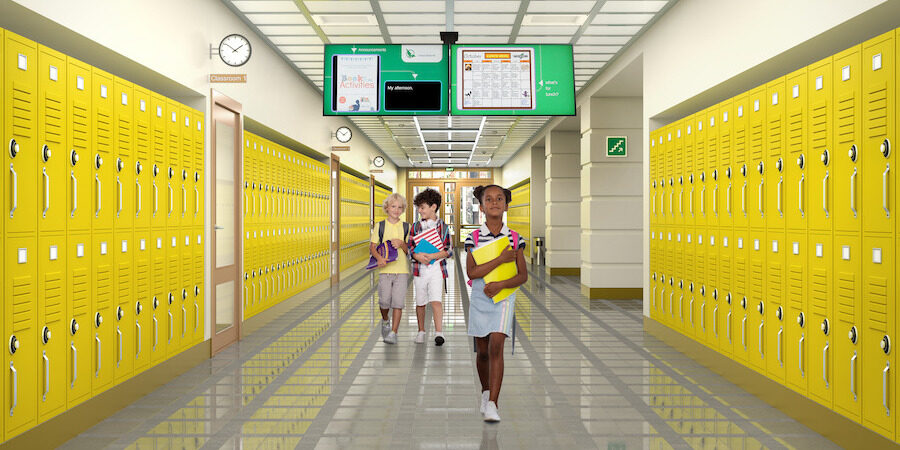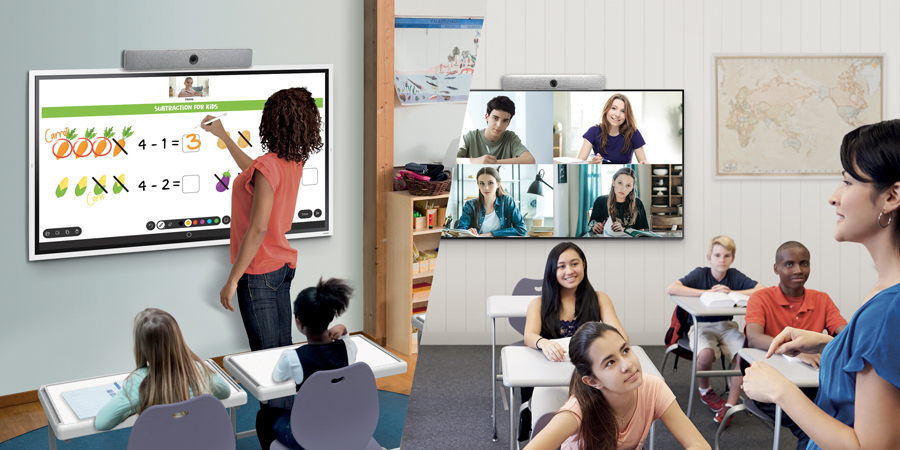Educators, administrators and students alike need instant access to emergency notifications while they’re on campus, and digital technology is the most efficient way to create real-time communications.
Digital signage displays deployed around campus and paired with school emergency management software and sensor systems can automatically trigger real-time safety alerts and instructions. Synced with data from building management systems, these alerts can provide guidance in a variety of situations when teacher and student safety is at risk. For example, the school’s carbon monoxide detectors, read by the smart software, could tell everyone to evacuate the building, while external, cloud-based weather data could tell everyone to stay inside and shelter in place.
When school alarm systems are going off, people tend to feel stressed and confused. Networked displays in hallways, common areas and even classrooms can make the difference between panic and calm — and between danger and safety.
Automated alerts
Networked digital signage displays around campus allow authorized users to create, schedule and distribute content on demand. But in an emergency, it might take a user several minutes to get to a PC, log in, set up a message and send it to the right screens.
To prevent this stressed rush, you can use predefined, automated notifications and messaging, ready to go — so they can be sent to displays without any human intervention. That’s the proposition presented by Florida IT services firm HAVRION, which has partnered with Samsung on an automated health and safety alert solution that pairs internet of things (IoT) sensor and building management systems with Samsung’s MagicINFO digital signage content management system (CMS).
Blended learning without limits
Simple, scalable and secure display solutions empower educators to take control of curriculum. Download Now
The integrated solution creates an automated conduit between your buildings’ systems and sensors and the Samsung software platform. Based on conditions and rules preset in the software, a notification from the HAVRION system dynamically triggers predetermined on-screen content.
In the case of a fire alarm, for example, screens in hallways can automatically provide directions to safe exits, with guidance tailored to each screen’s location — minimizing the risk of anyone going toward danger. Automation also means you’re not limited by human factors, as notifications and messaging aren’t contingent on a designated staff member getting to a PC and using the software manually.
Contextual displays
Schools of all kinds and with students of all ages have been adopting digital signage technology as a versatile solution for everything from celebrating student achievements and promoting events to relaying lunch menus and providing updated bus schedules.
Large flat-panel displays are primarily being used in common areas, lobbies and busy hallways where students and educators congregate. Instead of muffled morning announcements over an intercom or printed letters that disappear in backpacks, digital displays deliver key messages more effectively — and can repeat them all day if necessary. Outdoor monument displays are also being used to communicate emergency and non-emergency information to parents and students as they arrive at the school.
In their classrooms, educators can use digital displays to teach. The same displays used for digital signage messaging can also be used as a secondary screen for students to see lessons clearly or a way for teachers to connect with students who are learning at home. When a screen isn’t needed for instruction or collaboration, it can showcase the same messages seen in the hallways and provide critical information during an emergency situation.
Most Samsung commercial displays used for digital signage come equipped with embedded media players, so you’re spared the cost of a dedicated media playback device and can enjoy a simpler deployment. Samsung smart signage screens are built ready for integrations with systems like HAVRION, right out of the box.
Connect and protect
The HAVRION system leverages Samsung’s MagicINFO platform, which acts as the system’s connective tissue. MagicINFO, the first digital signage CMS to acquire both ISO27001 and ISO27701 certification, uses software and data handshakes — aka application programming interfaces (APIs) — to integrate an unlimited number of inputs and sensors. This allows HAVRION to deliver dynamic site, on-campus and district-wide video connectivity on Samsung smart displays — for alerts, notifications, customized messaging, video streaming and more.
HAVRION has two core modules:
- Connect by HAVRION: The software integration piece of HAVRION, Connect joins an educational environment’s physical and digital assets, enabling end-to-end detection and communication. Connect gives you the tools to link disparate devices, such as your HVAC and fire systems, and then build and format your screens’ notifications and guidance, such as zone-by-zone evacuation routes and procedures.
- Protect by HAVRION: A series of micro-services within HAVRION, Protect is designed to create dynamic evacuation routes, driven by artificial intelligence (AI) algorithms that work in tandem with your sensors. Different types of sensors can detect everything from noxious gases to the sound of gunshots. Protect’s real-time AI code analyzes environmental changes, movement and maps to provide the safest and quickest route to evacuation. As a result, Protect can mitigate emergencies like active shooter situations, fires and natural disasters, which tend to evolve rapidly and depend on real-time information.
“We’re focused on enabling clients to use IoT devices to detect the conditions in their environments that could impact the safety and security of students, staff, employees or guests and provide simple, clear contextual information on what to do next,” says Daniel Rodriguez, chief technology officer of HAVRION. “We accomplish this by using our software and hardware technology to connect sensors to various communications platforms.”
Real-time knowledge
In health and safety emergencies, time and proximity can be a matter of life and death. With the convergence of IoT, school emergency management software and digital displays, educators can now communicate more effectively and automatically to keep students safe.
With Samsung’s MagicINFO CMS, your digital displays are constantly supported by a highly secure, user-friendly backbone. Discover more about how the solution works in this free guide. If you’re not sure MagicINFO suits your needs, get tips on how to choose the right CMS for your digital signage network.








